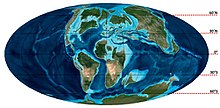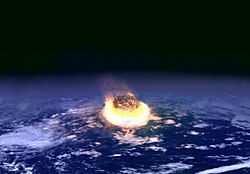Late Cretaceous
This article needs additional citations for verification. (February 2024) |
| Late/Upper Cretaceous | |||||||
|---|---|---|---|---|---|---|---|
| Chronology | |||||||
The Late Cretaceous (100.5–66 Period is divided in the geologic time scale. Rock strata from this epoch form the Upper Cretaceous Series. The Cretaceous is named after creta, the Latin word for the white limestone known as chalk. The chalk of northern France and the white cliffs of south-eastern England date from the Cretaceous Period.[3]
ClimateDuring the Late Cretaceous, the climate was warmer than present, although throughout the period a cooling trend is evident.[4] The tropics became restricted to equatorial regions and northern latitudes experienced markedly more seasonal climatic conditions.[4] Geography Due to plate tectonics, the Americas were gradually moving westward, causing the Atlantic Ocean to expand. The Western Interior Seaway divided North America into eastern and western halves; Appalachia and Laramidia.[4] India maintained a northward course towards Asia.[4] In the Southern Hemisphere, Australia and Antarctica seem to have remained connected and began to drift away from Africa and South America.[4] Europe was an island chain.[4] Populating some of these islands were endemic dwarf dinosaur species.[4] Vertebrate faunaNon-avian dinosaursIn the Late Cretaceous, the titanosaurs being among the dominant herbivores.[4]
Spinosaurids were also present during this time.[5]
BirdsBirds became increasingly common, diversifying in a variety of Neornithes such as Vegavis[6] co-existed with forms as bizarre as Yungavolucris and Avisaurus.[7] Though mostly small, marine Hesperornithes became relatively large and flightless, adapted to life in the open sea.[8]
PterosaursThough primarily represented by azhdarchids, other forms like pteranodontids, tapejarids (Caiuajara and Bakonydraco), nyctosaurids and uncertain forms (Piksi, Navajodactylus) are also present. Historically, it has been assumed that pterosaurs were in decline due to competition with birds, but it appears that neither group overlapped significantly ecologically, nor is it particularly evident that a true systematic decline was ever in place, especially with the discovery of smaller pterosaur species.[9] MammalsSeveral old eutherians; monotremes were presumably present, as was the last of the haramiyidans , Avashishta.
Mammals, though generally small, ranged into a variety of ecological niches, from carnivores ( Brandoniidae).[citation needed ]
True placentals evolved only at the very end of the epoch; the same can be said for true marsupials . Instead, nearly all known eutherian and metatherian fossils belong to other groups.
[11]
Marine lifeIn the seas, Cenomanian-Turonian anoxic event.[citation needed ]
FloraNear the end of the Cretaceous Period, Cretaceous–Paleogene mass extinction discoveryThe Cretaceous–Paleogene extinction event was a large-scale mass extinction of animal and plant species in a geologically short period of time, approximately 66 million years ago (Ma). It is widely known as the K–T extinction event and is associated with a geological signature, usually a thin band dated to that time and found in various parts of the world, known as the Cretaceous–Paleogene boundary (K–T boundary). K is the traditional abbreviation for the Cretaceous Period derived from the German name Kreidezeit, and T is the abbreviation for the Tertiary Period (a historical term for the period of time now covered by the Paleogene and Neogene periods). The event marks the end of the Mesozoic Era and the beginning of the Cenozoic Era.[12] "Tertiary" being no longer recognized as a formal time or rock unit by the International Commission on Stratigraphy, the K-T event is now called the Cretaceous—Paleogene (or K-Pg) extinction event by many researchers.  Non- Mammalian and bird clades passed through the boundary with few extinctions, and evolutionary radiation from those Maastrichtian clades occurred well past the boundary. Rates of extinction and radiation varied across different clades of organisms.[17]
Many scientists hypothesize that the Cretaceous–Paleogene extinctions were caused by catastrophic events such as the massive asteroid impact that caused the Chicxulub crater, in combination with increased volcanic activity, such as that recorded in the Deccan Traps, both of which have been firmly dated to the time of the extinction event. In theory, these events reduced sunlight and hindered photosynthesis, leading to a massive disruption in Earth's ecology. A much smaller number of researchers believe the extinction was more gradual, resulting from slower changes in sea level or climate.[17] See also
References
| |||||||
